Text
New York Expects Health Care Worker Shortages Ahead Of Vaccine Mandate Deadline – NPR
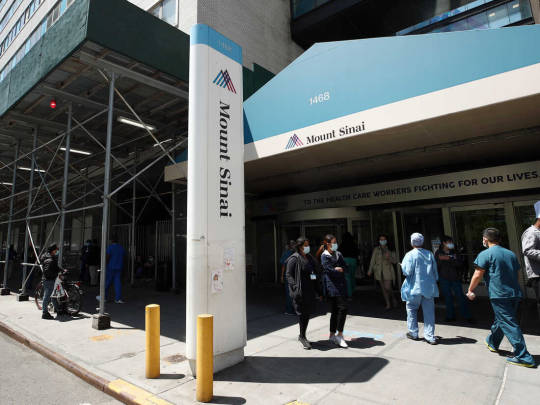
A view of the entrance to Mount Sinai Hospital in New York City on May 14, 2020. Hospital and nursing home workers across New York are required to have at least one dose of a COVID-19 vaccine by Monday, prompting concerns over noncompliance and potential staffing shortages. Cindy Ord/Getty Images hide caption
toggle caption
Cindy Ord/Getty Images
A view of the entrance to Mount Sinai Hospital in New York City on May 14, 2020. Hospital and nursing home workers across New York are required to have at least one dose of a COVID-19 vaccine by Monday, prompting concerns over noncompliance and potential staffing shortages.
Cindy Ord/Getty Images
New York state officials are bracing for staffing shortages when the state’s health care worker vaccination mandate takes effect on Monday, and could be looking to the National Guard — as well as medical professionals from other states and countries — to help address them.
Gov. Kathy Hochul released a plan on Saturday, outlining the steps she could take to increase the workforce in the event that large numbers of hospital and nursing home employees do not meet the state’s deadline.
“We are still in a battle against COVID to protect our loved ones, and we need to fight with every tool at our disposal,” she said.

That could mean declaring a state of emergency to allow health care professionals licensed outside of New York, as well as recent graduates and retirees, to practice there. Other options include deploying medically trained National Guard members, partnering with the federal government to send Disaster Medical Assistance Teams to local health and medical systems and “exploring ways to expedite visa requests for medical professionals.”
The state’s labor department has also issued guidance clarifying that workers who are terminated because they refuse to be vaccinated will not be eligible for unemployment insurance, “absent a valid doctor-approved request for medical accommodation.”
All health care workers at New York’s hospitals and nursing homes are required to have at least one dose of a COVID-19 vaccine by Monday, according to state regulations and a mandate issued by former Gov. Andrew Cuomo last month. Staff at other institutions including home care, hospice and adult care facilities must be vaccinated by Oct. 7.

The most recent numbers suggest the state still has a ways to go: As of Wednesday, 84% of all hospital employees were fully vaccinated. And 81% of staff at all adult care facilities and 77% of nursing home facility staff were fully vaccinated as of Thursday.
Health care systems statewide and nationally are already struggling with staffing shortages.
Critics of the requirement have challenged it through protests and lawsuits, as North Country Public Radio reports, opposing mandatory vaccination and challenging the lack of exemptions for religious objections.
At this point, health care workers have the option to apply for a religious exemption until at least Oct.12, when a federal judge will consider a legal challenge in favor of such exemptions.
As hospitals readied their contingency plans — which for many includes limiting certain procedures — late last week, Hochul held firm to the deadline. She told reporters on Thursday that there are “no excuses” for workers refusing to get vaccinated, and called the impending shortages “completely avoidable.”
How health care systems are preparing for the deadline
Hospital systems and nursing homes across the state are encouraging their employees to get vaccinated, and preparing for disruptions if they do not. Some are cutting back on elective surgeries, limiting admissions and retaining volunteers.
Northwell Health, the state’s largest health care provider, has been holding meetings with staffers in an effort to persuade “thousands of holdouts,” The Associated Press reports. Some 90% of its 74,000 active personnel had been vaccinated as of Thursday, though the hospital said it’s not expecting full compliance and has more than 3,000 retirees, students and volunteers on standby.
Erie County Medical Center Corporation in Buffalo anticipates that roughly 10% of its workforce (some 400 workers) may not get vaccinated by Monday, according to AP, and is prepared to potentially suspend elective inpatient surgeries, reduce hours at outpatient clinics and temporarily stop accepting ICU transfers.
As NPR has reported, Lewis County General Hospital in Lowville, N.Y., said it would pause maternity services starting this weekend because dozens of staff members quit rather than get vaccinated.

Unvaccinated employees of New York City’s 11 public hospitals (which cites a roughly 88% compliance rate) will be put on unpaid leave but could return to work if they get vaccinated soon, CNN reports.
Some hospital systems are seeing an increase in vaccination rates. New York-Presbyterian, for example, enacted its own mandate with a deadline of midnight on Wednesday, and reported that only about 250 of its 48,000 staffers did not comply.
The University of Rochester Medical Center said in a statement that 99% of professional medical staff and 91% of all employees across its six hospitals were partially or fully vaccinated as of last week.
Dr. Michael Apostolakos, its chief medical officer, said that critical care and many-critical services will continue uninterrupted — but staffing shortages unrelated to the mandate are prompting a pause in some services.
Patients will see longer wait times for routine appointments, some employees will be asked to take on additional responsibilities and beds could be temporarily closed, Apostolakos said in a statement.
One piece of a national conversation
New York is not the only place mandating vaccinations for health care workers — California announced a similar policy over the summer, and the U.S. Department of Veterans Affairs is also requiring front-line health care workers to get vaccinated.
President Biden announced earlier this month that the 17 million health care workers at facilities that receive Medicare or Medicaid funding will have to be vaccinated or regularly tested, with details to be finalized in the weeks ahead.
While such workplace requirements have the support of many public health experts — and more than half of nurses, according to one recent survey — some politicians and hospital officials have expressed concern. And that’s especially true in rural areas, where vaccination rates are low and hiring is already difficult.

Chiquita Brooks-LaSure, the administrator of the Centers for Medicare and Medicaid Services, told NPR that the Biden administration is pursuing a mandate because of how stagnant vaccination rates are in the country’s hospitals. She noted that while many hospitals are worried about staffing shortages, employees missing work because of illness or quarantine is an issue of both staffing too — and safety.
“It’s very clear from the data that staff who remain unvaccinated are affecting both the patients who are coming in to the facilities as well as their colleagues,” she said.
It remains to be seen how severe staffing shortages will be, in New York and elsewhere. Though one state has already enacted a health care worker vaccination mandate, and could serve as one data point.
Maine’s governor announced a mandate for health care workers in mid-August, and hospitals are only reporting a handful of resignations so far — though enforcement doesn’t start until Oct. 29.
source https://wealthch.com/new-york-expects-health-care-worker-shortages-ahead-of-vaccine-mandate-deadline-npr/
0 notes
Text
Capricor’s muscle drug data look good, but partner wanted and Phase 3 test needed
Capricor Therapeutics has been performing a balancing act with its lead drug for more than a year. After the cell therapy posted positive mid-stage data in May 2020 for the rare disease Duchenne muscular dystrophy, the company began shopping the asset to potential partners. Along the way, the biotech spoke with the FDA multiple times, trying to find a path to file for accelerated approval based on the preliminary Phase 2 results.
So far, no pharma partner has signed on, perhaps because no company wants to take on the therapy, CAP-1002, without knowing for sure what the next regulatory steps will be. The FDA urged Capricor to conduct a Phase 3 test, and the biotech is now preparing to do so. But the partnering search continues, and Capricor has a fresh analysis of the full Phase 2 data so suitors will have a better look at what they could be getting (and what more the FDA wants to see). Beverly Hills, California-based Capricor presented those results Friday at the World Muscle Society Virtual Congress.
Duchenne is an inherited disorder in which patients are unable to produce a key muscle protein, causing them to develop progressive weakening of skeletal and cardiac muscle. The disease leads to death by the late teens or early 20s. There is no cure, but drugs have been developed and approved to treat the condition. The first, an antisense oligonucleotide from Sarepta Therapeutics, is designed to get cells to produce a version of the key muscle protein that Duchenne patients lack.
Capricor’s CAP-1002 is derived from cells that come from donated heart muscle. The cell therapy does not engraft into the host’s tissue. It works by secreting exosomes, tiny vesicles carrying lipids, proteins, and nucleic acids. That cargo is delivered into target cells. Capricor scientists believe that this approach decreases inflammation and slows muscle degeneration, and perhaps even sparks muscle regeneration.
The Phase 2 test of CAP-1002 was a placebo-controlled study enrolling 20 boys and young men with Duchenne, all of them already receiving corticosteroids that can slow muscle damage and weakness. About 80% of the study participants were unable to walk. All of the patients were randomly assigned to groups given either an infusion of the cell therapy or a placebo every three months for one year. The main goal was to assess patients according to Performance of the Upper Limb (PUL), a rating scale designed to assess shoulder, elbow, and wrist and hand function.
In the study, eight patients received the treatment while 12 were given a placebo. Craig McDonald, chair of the Department of Physical Medicine and Rehabilitation at the University of California, Davis, and the lead investigator for the clinical trial, said on a conference call Friday that the results showed that the patients treated with CAP-1002 had statistically significant changes in both skeletal and cardiac function. The therapy was well tolerated by patients. Two patients experienced hypersensitivity reactions early in the study, which were mitigated with a pre-medication regiment. No serious safety signals were reported.
Beyond showing statistically significant changes according to PUL, McDonald said that the results translated into improvements in the daily lives of patients. He explained that PUL is highly predictive of the loss of hand-to-mouth function, and patient advocacy groups say that the measure is clinically meaningful.
“The complete loss of hand-to-mouth function makes someone totally depending on others for feeding, scratching their nose, scratching their scalp or getting their hand to the scalp to be able to comb their hair, or even be able to brush their teeth independently,” he said.
The first FDA-approved Duchenne therapy, Sarepta’s Exondys 51, addresses a subset of patients who have a particular genetic mutation. The approval was based on a small, open-label study whose results, measured by a walking test, were unclear about how well the treatment worked. The Cambridge, Massachusetts-based biotech has since won approvals for two more Duchenne therapies. Last summer, the FDA approved yet another Duchenne treatment, NS Pharma drug Viltepso.
The Sarapeta and NS Pharma drugs reached the market under accelerated approval decisions. Each of those therapies addresses subsets of Duchenne patients with rare genetic mutations. Capricor’s experimental treatment does not address any particular genetic subset of patients, and that could be one reason why the FDA wants to see more data from a larger group. Capricor CEO Linda Marbán said the FDA recognizes the strength of CAP-1002’s data, as well as the potential clinical significance. However, the agency told the company that the sample size was too small to grant accelerated approval, and therefore asked the company to conduct a larger Phase 3 clinical trial.
The Phase 3 test of CAP-1002 will enroll 65 to 75 patients at up to 20 U.S. sites, Marbán said. In addition to being larger, this study will also include patients who are younger and still have the ability to walk. Based on the FDA’s feedback, the main goal will be to assess PUL. Meanwhile, Capricor is still looking for a larger company that can partner on the development and potential commercialization of the drug.
Capricor previously had a partner for CAP-1002. The cell therapy was first tested in cardiovascular applications. In 2014, Johnson & Johnson’s Janssen Biotech subsidiary struck up an alliance, paying $12.5 million up front to gain an option to develop the therapy. Janssen returned the rights to the experimental treatment in 2017 after Phase 2 results showed the drug was unlikely to be successful in reducing scar tissue caused by a heart attack. That failure led the company to shift its focus to developing CAP-1002 for Duchenne.
Marbán said Capricor is in “active discussions” with several potential partners. The company aims to secure a partnership before clinical trial enrollment begins.
Public domain image by Flickr user Berkshire Community College Bioscience Image Library
source https://wealthch.com/capricors-muscle-drug-data-look-good-but-partner-wanted-and-phase-3-test-needed/
0 notes
Text
8 Tips to Burn More Calories by Walking
Walking is seriously underrated in terms of its benefits as an exercise. Oftentimes we feel as though we must get drenched in sweat to burn calories. In reality, walking really can do wonders to help boost your burn! Don’t get us wrong; cycling, running and all of those intense cardio activities are wonderful. But maybe you don’t always have time to hit the gym or go for a full-blown run.
Sometimes, fitting in a couple of walks can feel a lot more doable.
Fortunately, research supports the benefits of walking. A study, published in the British Journal of Sports Medicine, found that those who stuck with a walking program had significant improvements in blood pressure, reduction of body fat and body weight and overall better quality of life.
To help you burn more calories, we’ve rounded up eight easy tips for your walking workout.


1. Walk on an incline, a hill or stairs.
Going up? Walking on a treadmill that is tilted at an incline, walking up a hill outside or even walking on stairs can all increase the intensity of your workout. This means you’ll burn more calories than walking on level ground. It may also be better for your health. One study, published in the Journal of Sports Science and Medicine, has shown that uphill walking can help your body metabolize both glucose and lipids, which means it might be beneficial for “the prevention of type 2 diabetes and disorders in lipid metabolism.”
2. Use an activity tracker or step counter to stay motivated.
Wearing a watch or a device that provides activity tracking capabilities and/or step counting can help motivate you to walk longer or faster. Without any sense of how far you’ve walked or how many calories you’ve burned, it can be easy to “quit early.” But if you see that you’re just a few tenths away from the next mile—or that you’re incredibly close to meeting your daily step goal—it can push you to go a little bit longer. That kind of motivation can pay off in terms of your results.
3. Listen to tunes.
Did you know that music can have an impact on your weight loss goals? A study, published in the journal Psychology of Sport and Exercise, found that listening to music led to a 28 percent increase in activity enjoyment. That can equate to walking for longer—and burning more calories. People also commonly report that music helps them increase the speed and intensity of their work. It puts a little zip in your step!


4. Walk with a pal.
While music can motivate the solo walker, having a friend to talk to can also be motivating. Research carried out by Virgin Active Health Clubs found that exercising with a friend can burn more calories than working out alone. The reason may be that chatting with a good pal is distracting and helps you go further. When friends walk together, they also pace one another. You might be motivated to walk faster than you would alone.
5. Make sure you have the right shoes.
A good pair of walking shoes really can make all the difference in the world when it comes to inspiration to go further. If you’ve ever walked a long distance in unsupportive shoes, then you know how much your feet started to hurt. But when you have footwear that is comfortable and provides good shock absorption, you can walk longer and faster—and torch more calories as a result.
6. Move your arms as you walk—and pick up the pace.
Adding arm movement during your walk can help you to go faster. It can turn a regular walk into a power walk—and that can help increase your burn. Research, published in Nature Medicine, found that the intensity of an activity can be more important than its duration. In other words, a shorter power walk can be more calorie-smashing than a long and leisurely stroll.


7. Take a hike!
Instead of walking around your neighborhood or town, why not drive to a local trail and take a hike? Hiking on uneven ground and different terrains can activate different muscles than you’re used to using on flat surfaces. You’ll be strengthening muscles in the knees, hips and ankles—areas that don’t usually get much use. The changes in terrain typically mean more calories burned, too.
8. Incorporate interval training into your walking program.
If you’ve ever participated in an interval run, then you know it incorporates short bursts of sprinting into your jog. You can do the same thing walking by increasing the intensity to a power walk at each interval. The idea is to keep the interval short enough that you won’t get completely exhausted and can keep going. This can help you burn more calories while walking.
Pair your walking workout with a convenient meal delivery service! Get started with Nutrisystem today >


source https://wealthch.com/8-tips-to-burn-more-calories-by-walking/
0 notes
Link
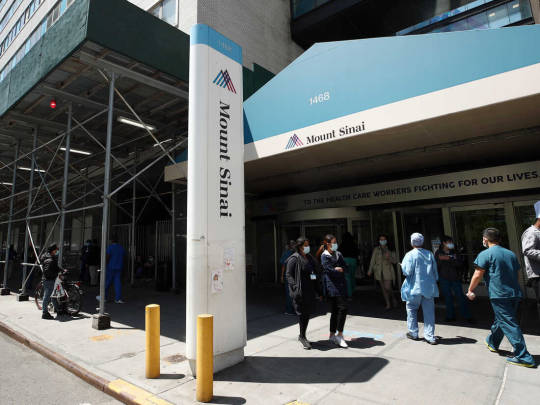
A view of the entrance to Mount Sinai Hospital in New York City on May 14, 2020. Hospital and nursing home workers across New York are required to have at least one dose of a COVID-19 vaccine by Monday, prompting concerns over noncompliance and potential staffing shortages. Cindy Ord/Getty Images hide caption
toggle caption
Cindy Ord/Getty Images
A view of the entrance to Mount Sinai Hospital in New York City on May 14, 2020. Hospital and nursing home workers across New York are required to have at least one dose of a COVID-19 vaccine by Monday, prompting concerns over noncompliance and potential staffing shortages.
Cindy Ord/Getty Images
New York state officials are bracing for staffing shortages when the state’s health care worker vaccination mandate takes effect on Monday, and could be looking to the National Guard — as well as medical professionals from other states and countries — to help address them.
Gov. Kathy Hochul released a plan on Saturday, outlining the steps she could take to increase the workforce in the event that large numbers of hospital and nursing home employees do not meet the state’s deadline.
“We are still in a battle against COVID to protect our loved ones, and we need to fight with every tool at our disposal,” she said.

That could mean declaring a state of emergency to allow health care professionals licensed outside of New York, as well as recent graduates and retirees, to practice there. Other options include deploying medically trained National Guard members, partnering with the federal government to send Disaster Medical Assistance Teams to local health and medical systems and “exploring ways to expedite visa requests for medical professionals.”
The state’s labor department has also issued guidance clarifying that workers who are terminated because they refuse to be vaccinated will not be eligible for unemployment insurance, “absent a valid doctor-approved request for medical accommodation.”
All health care workers at New York’s hospitals and nursing homes are required to have at least one dose of a COVID-19 vaccine by Monday, according to state regulations and a mandate issued by former Gov. Andrew Cuomo last month. Staff at other institutions including home care, hospice and adult care facilities must be vaccinated by Oct. 7.

The most recent numbers suggest the state still has a ways to go: As of Wednesday, 84% of all hospital employees were fully vaccinated. And 81% of staff at all adult care facilities and 77% of nursing home facility staff were fully vaccinated as of Thursday.
Health care systems statewide and nationally are already struggling with staffing shortages.
Critics of the requirement have challenged it through protests and lawsuits, as North Country Public Radio reports, opposing mandatory vaccination and challenging the lack of exemptions for religious objections.
At this point, health care workers have the option to apply for a religious exemption until at least Oct.12, when a federal judge will consider a legal challenge in favor of such exemptions.
As hospitals readied their contingency plans — which for many includes limiting certain procedures — late last week, Hochul held firm to the deadline. She told reporters on Thursday that there are “no excuses” for workers refusing to get vaccinated, and called the impending shortages “completely avoidable.”
How health care systems are preparing for the deadline
Hospital systems and nursing homes across the state are encouraging their employees to get vaccinated, and preparing for disruptions if they do not. Some are cutting back on elective surgeries, limiting admissions and retaining volunteers.
Northwell Health, the state’s largest health care provider, has been holding meetings with staffers in an effort to persuade “thousands of holdouts,” The Associated Press reports. Some 90% of its 74,000 active personnel had been vaccinated as of Thursday, though the hospital said it’s not expecting full compliance and has more than 3,000 retirees, students and volunteers on standby.
Erie County Medical Center Corporation in Buffalo anticipates that roughly 10% of its workforce (some 400 workers) may not get vaccinated by Monday, according to AP, and is prepared to potentially suspend elective inpatient surgeries, reduce hours at outpatient clinics and temporarily stop accepting ICU transfers.
As NPR has reported, Lewis County General Hospital in Lowville, N.Y., said it would pause maternity services starting this weekend because dozens of staff members quit rather than get vaccinated.

Unvaccinated employees of New York City’s 11 public hospitals (which cites a roughly 88% compliance rate) will be put on unpaid leave but could return to work if they get vaccinated soon, CNN reports.
Some hospital systems are seeing an increase in vaccination rates. New York-Presbyterian, for example, enacted its own mandate with a deadline of midnight on Wednesday, and reported that only about 250 of its 48,000 staffers did not comply.
The University of Rochester Medical Center said in a statement that 99% of professional medical staff and 91% of all employees across its six hospitals were partially or fully vaccinated as of last week.
Dr. Michael Apostolakos, its chief medical officer, said that critical care and many-critical services will continue uninterrupted — but staffing shortages unrelated to the mandate are prompting a pause in some services.
Patients will see longer wait times for routine appointments, some employees will be asked to take on additional responsibilities and beds could be temporarily closed, Apostolakos said in a statement.
One piece of a national conversation
New York is not the only place mandating vaccinations for health care workers — California announced a similar policy over the summer, and the U.S. Department of Veterans Affairs is also requiring front-line health care workers to get vaccinated.
President Biden announced earlier this month that the 17 million health care workers at facilities that receive Medicare or Medicaid funding will have to be vaccinated or regularly tested, with details to be finalized in the weeks ahead.
While such workplace requirements have the support of many public health experts — and more than half of nurses, according to one recent survey — some politicians and hospital officials have expressed concern. And that’s especially true in rural areas, where vaccination rates are low and hiring is already difficult.

Chiquita Brooks-LaSure, the administrator of the Centers for Medicare and Medicaid Services, told NPR that the Biden administration is pursuing a mandate because of how stagnant vaccination rates are in the country’s hospitals. She noted that while many hospitals are worried about staffing shortages, employees missing work because of illness or quarantine is an issue of both staffing too — and safety.
“It’s very clear from the data that staff who remain unvaccinated are affecting both the patients who are coming in to the facilities as well as their colleagues,” she said.
It remains to be seen how severe staffing shortages will be, in New York and elsewhere. Though one state has already enacted a health care worker vaccination mandate, and could serve as one data point.
Maine’s governor announced a mandate for health care workers in mid-August, and hospitals are only reporting a handful of resignations so far — though enforcement doesn’t start until Oct. 29.
via Wealth Health
0 notes
Link
Capricor Therapeutics has been performing a balancing act with its lead drug for more than a year. After the cell therapy posted positive mid-stage data in May 2020 for the rare disease Duchenne muscular dystrophy, the company began shopping the asset to potential partners. Along the way, the biotech spoke with the FDA multiple times, trying to find a path to file for accelerated approval based on the preliminary Phase 2 results.
So far, no pharma partner has signed on, perhaps because no company wants to take on the therapy, CAP-1002, without knowing for sure what the next regulatory steps will be. The FDA urged Capricor to conduct a Phase 3 test, and the biotech is now preparing to do so. But the partnering search continues, and Capricor has a fresh analysis of the full Phase 2 data so suitors will have a better look at what they could be getting (and what more the FDA wants to see). Beverly Hills, California-based Capricor presented those results Friday at the World Muscle Society Virtual Congress.
Duchenne is an inherited disorder in which patients are unable to produce a key muscle protein, causing them to develop progressive weakening of skeletal and cardiac muscle. The disease leads to death by the late teens or early 20s. There is no cure, but drugs have been developed and approved to treat the condition. The first, an antisense oligonucleotide from Sarepta Therapeutics, is designed to get cells to produce a version of the key muscle protein that Duchenne patients lack.
Capricor’s CAP-1002 is derived from cells that come from donated heart muscle. The cell therapy does not engraft into the host’s tissue. It works by secreting exosomes, tiny vesicles carrying lipids, proteins, and nucleic acids. That cargo is delivered into target cells. Capricor scientists believe that this approach decreases inflammation and slows muscle degeneration, and perhaps even sparks muscle regeneration.
The Phase 2 test of CAP-1002 was a placebo-controlled study enrolling 20 boys and young men with Duchenne, all of them already receiving corticosteroids that can slow muscle damage and weakness. About 80% of the study participants were unable to walk. All of the patients were randomly assigned to groups given either an infusion of the cell therapy or a placebo every three months for one year. The main goal was to assess patients according to Performance of the Upper Limb (PUL), a rating scale designed to assess shoulder, elbow, and wrist and hand function.
In the study, eight patients received the treatment while 12 were given a placebo. Craig McDonald, chair of the Department of Physical Medicine and Rehabilitation at the University of California, Davis, and the lead investigator for the clinical trial, said on a conference call Friday that the results showed that the patients treated with CAP-1002 had statistically significant changes in both skeletal and cardiac function. The therapy was well tolerated by patients. Two patients experienced hypersensitivity reactions early in the study, which were mitigated with a pre-medication regiment. No serious safety signals were reported.
Beyond showing statistically significant changes according to PUL, McDonald said that the results translated into improvements in the daily lives of patients. He explained that PUL is highly predictive of the loss of hand-to-mouth function, and patient advocacy groups say that the measure is clinically meaningful.
“The complete loss of hand-to-mouth function makes someone totally depending on others for feeding, scratching their nose, scratching their scalp or getting their hand to the scalp to be able to comb their hair, or even be able to brush their teeth independently,” he said.
The first FDA-approved Duchenne therapy, Sarepta’s Exondys 51, addresses a subset of patients who have a particular genetic mutation. The approval was based on a small, open-label study whose results, measured by a walking test, were unclear about how well the treatment worked. The Cambridge, Massachusetts-based biotech has since won approvals for two more Duchenne therapies. Last summer, the FDA approved yet another Duchenne treatment, NS Pharma drug Viltepso.
The Sarapeta and NS Pharma drugs reached the market under accelerated approval decisions. Each of those therapies addresses subsets of Duchenne patients with rare genetic mutations. Capricor’s experimental treatment does not address any particular genetic subset of patients, and that could be one reason why the FDA wants to see more data from a larger group. Capricor CEO Linda Marbán said the FDA recognizes the strength of CAP-1002’s data, as well as the potential clinical significance. However, the agency told the company that the sample size was too small to grant accelerated approval, and therefore asked the company to conduct a larger Phase 3 clinical trial.
The Phase 3 test of CAP-1002 will enroll 65 to 75 patients at up to 20 U.S. sites, Marbán said. In addition to being larger, this study will also include patients who are younger and still have the ability to walk. Based on the FDA’s feedback, the main goal will be to assess PUL. Meanwhile, Capricor is still looking for a larger company that can partner on the development and potential commercialization of the drug.
Capricor previously had a partner for CAP-1002. The cell therapy was first tested in cardiovascular applications. In 2014, Johnson & Johnson’s Janssen Biotech subsidiary struck up an alliance, paying $12.5 million up front to gain an option to develop the therapy. Janssen returned the rights to the experimental treatment in 2017 after Phase 2 results showed the drug was unlikely to be successful in reducing scar tissue caused by a heart attack. That failure led the company to shift its focus to developing CAP-1002 for Duchenne.
Marbán said Capricor is in “active discussions” with several potential partners. The company aims to secure a partnership before clinical trial enrollment begins.
Public domain image by Flickr user Berkshire Community College Bioscience Image Library
via Wealth Health
0 notes
Link
Walking is seriously underrated in terms of its benefits as an exercise. Oftentimes we feel as though we must get drenched in sweat to burn calories. In reality, walking really can do wonders to help boost your burn! Don’t get us wrong; cycling, running and all of those intense cardio activities are wonderful. But maybe you don’t always have time to hit the gym or go for a full-blown run.
Sometimes, fitting in a couple of walks can feel a lot more doable.
Fortunately, research supports the benefits of walking. A study, published in the British Journal of Sports Medicine, found that those who stuck with a walking program had significant improvements in blood pressure, reduction of body fat and body weight and overall better quality of life.
To help you burn more calories, we’ve rounded up eight easy tips for your walking workout.


1. Walk on an incline, a hill or stairs.
Going up? Walking on a treadmill that is tilted at an incline, walking up a hill outside or even walking on stairs can all increase the intensity of your workout. This means you’ll burn more calories than walking on level ground. It may also be better for your health. One study, published in the Journal of Sports Science and Medicine, has shown that uphill walking can help your body metabolize both glucose and lipids, which means it might be beneficial for “the prevention of type 2 diabetes and disorders in lipid metabolism.”
2. Use an activity tracker or step counter to stay motivated.
Wearing a watch or a device that provides activity tracking capabilities and/or step counting can help motivate you to walk longer or faster. Without any sense of how far you’ve walked or how many calories you’ve burned, it can be easy to “quit early.” But if you see that you’re just a few tenths away from the next mile—or that you’re incredibly close to meeting your daily step goal—it can push you to go a little bit longer. That kind of motivation can pay off in terms of your results.
3. Listen to tunes.
Did you know that music can have an impact on your weight loss goals? A study, published in the journal Psychology of Sport and Exercise, found that listening to music led to a 28 percent increase in activity enjoyment. That can equate to walking for longer—and burning more calories. People also commonly report that music helps them increase the speed and intensity of their work. It puts a little zip in your step!


4. Walk with a pal.
While music can motivate the solo walker, having a friend to talk to can also be motivating. Research carried out by Virgin Active Health Clubs found that exercising with a friend can burn more calories than working out alone. The reason may be that chatting with a good pal is distracting and helps you go further. When friends walk together, they also pace one another. You might be motivated to walk faster than you would alone.
5. Make sure you have the right shoes.
A good pair of walking shoes really can make all the difference in the world when it comes to inspiration to go further. If you’ve ever walked a long distance in unsupportive shoes, then you know how much your feet started to hurt. But when you have footwear that is comfortable and provides good shock absorption, you can walk longer and faster—and torch more calories as a result.
6. Move your arms as you walk—and pick up the pace.
Adding arm movement during your walk can help you to go faster. It can turn a regular walk into a power walk—and that can help increase your burn. Research, published in Nature Medicine, found that the intensity of an activity can be more important than its duration. In other words, a shorter power walk can be more calorie-smashing than a long and leisurely stroll.


7. Take a hike!
Instead of walking around your neighborhood or town, why not drive to a local trail and take a hike? Hiking on uneven ground and different terrains can activate different muscles than you’re used to using on flat surfaces. You’ll be strengthening muscles in the knees, hips and ankles—areas that don’t usually get much use. The changes in terrain typically mean more calories burned, too.
8. Incorporate interval training into your walking program.
If you’ve ever participated in an interval run, then you know it incorporates short bursts of sprinting into your jog. You can do the same thing walking by increasing the intensity to a power walk at each interval. The idea is to keep the interval short enough that you won’t get completely exhausted and can keep going. This can help you burn more calories while walking.
Pair your walking workout with a convenient meal delivery service! Get started with Nutrisystem today >


via Wealth Health
0 notes
Link
NEWS | FEATURES | PREVIEWS | EVENTS
originally published: 09/26/2021
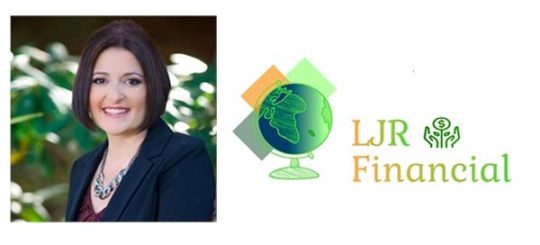
(JACKSON, NJ) — Emergency financial preparedness is a necessity for every family. The Ocean County Library Jackson Branch invites you to a fun, interactive financial planning seminar at on Thursday, October 14 at 2:00pm. Attendees will learn how to organize and maintain financial paperwork, determine when obsolete documents can be discarded, avoid money scams, and conduct estate planning. A question-and-answer period will follow.
“Achieving Financial Fitness” will be presented by certified financial planner and retirement planning counselor Laura Reeves, local business owner of LJR Financial.
Laura and her financial colleagues tailor financial portfolios that include investments, insurance, taxation, funding for education and health care, and legacy planning.
Registration at www.theoceancountylibrary.org/events is required for this free program.
Advertise with New Jersey Stage for $50-$100 per month, click here for info
Advertise with New Jersey Stage for $50-$100 per month, click here for info
via Wealth Health
0 notes
Text
“Achieving Financial Fitness” To Be Presented At Ocean County Library Jackson Branch – New Jersey Stage
NEWS | FEATURES | PREVIEWS | EVENTS
originally published: 09/26/2021
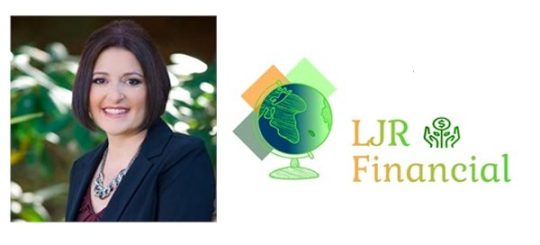
(JACKSON, NJ) — Emergency financial preparedness is a necessity for every family. The Ocean County Library Jackson Branch invites you to a fun, interactive financial planning seminar at on Thursday, October 14 at 2:00pm. Attendees will learn how to organize and maintain financial paperwork, determine when obsolete documents can be discarded, avoid money scams, and conduct estate planning. A question-and-answer period will follow.
“Achieving Financial Fitness” will be presented by certified financial planner and retirement planning counselor Laura Reeves, local business owner of LJR Financial.
Laura and her financial colleagues tailor financial portfolios that include investments, insurance, taxation, funding for education and health care, and legacy planning.
Registration at www.theoceancountylibrary.org/events is required for this free program.
Advertise with New Jersey Stage for $50-$100 per month, click here for info
Advertise with New Jersey Stage for $50-$100 per month, click here for info
source https://wealthch.com/achieving-financial-fitness-to-be-presented-at-ocean-county-library-jackson-branch-new-jersey-stage/
0 notes
Text
NY Weighs Using the National Guard to Replace Unvaccinated Health Care Workers – The New York Times

Gov. Kathy Hochul of New York is considering calling in the National Guard and recruiting medical professionals from other states to cover looming staff shortages at hospitals and other facilities as the likelihood grows that tens of thousands of health care workers will not meet the state’s deadlines for mandated vaccinations.
In a statement released on Saturday, the governor’s office said Ms. Hochul was laying plans for an executive order to declare a state of emergency that would “allow qualified health care professionals licensed in other states or countries, recent graduates, retired and formerly practicing health care professionals to practice in New York State.”
Other options, the statement said, included calling in medically trained National Guard members to deliver care and to work with the federal government to deploy Disaster Medical Assistance Teams, which are operated by the Department for Health and Human Services.
Hospital and nursing home employees in New York are required to receive a first dose of a Covid-19 vaccine by 11:59 p.m. on Monday night, while workers working in home care, hospices and other adult care facilities must do so by Oct. 7, according to state regulations and a mandate issued on Aug. 16 by former Gov. Andrew M. Cuomo.
State vaccination figures show that, as of Wednesday, 16 percent of the state’s roughly 450,000 hospital workers, or about 70,000, were not fully vaccinated. The data show that 15 percent of staff at skilled nursing facilities and 14 percent of workers at adult care facilities are also not fully vaccinated, representing another 25,000 or so workers.
Eileen Toback, executive director of the New York Professional Nurses Union, which represents 1,500 nurses in Manhattan and supported the vaccine mandate, said she appreciated that Ms. Hochul was trying to address possible staffing shortages. But Ms. Toback criticized the state for issuing the plan only 48 hours before thousands of health care workers could lose their jobs.
“That could be devastating, particularly when hospitals staff only the exact numbers they need,” Ms. Toback said. “There’s no fat on that bone.”
Ms. Toback said about 5 percent of her union’s members have not been vaccinated. “I believe a lot of unvaccinated employees, not just nurses, are banking on the fact that they are so necessary that they won’t be terminated, and they are holding out,” she said.
The governor’s office said workers terminated because they refuse to be vaccinated are not eligible for unemployment insurance unless they provide a doctor-approved request for a medical accommodation.
In announcing New York’s determination to enforce its deadline, Ms. Hochul said, “We are still in a battle against Covid to protect our loved ones, and we need to fight with every tool at our disposal.” She also commended the vast majority of state health care workers for getting vaccinated and urged “all remaining health care workers who are unvaccinated to do so now so they can continue providing care.”
The Greater New York Hospital Association, which represents about 140 health systems and 55 nursing homes, had not issued a response to the governor’s plan but has supported the deadline for health care workers’ vaccinations, signaling that staffing shortages can be managed.
Understand Vaccine and Mask Mandates in the U.S.
Vaccine rules. On Aug. 23, the Food and Drug Administration granted full approval to Pfizer-BioNTech’s coronavirus vaccine for people 16 and up, paving the way for an increase in mandates in both the public and private sectors. Private companies have been increasingly mandating vaccines for employees. Such mandates are legally allowed and have been upheld in court challenges.
Mask rules. The Centers for Disease Control and Prevention in July recommended that all Americans, regardless of vaccination status, wear masks in indoor public places within areas experiencing outbreaks, a reversal of the guidance it offered in May. See where the C.D.C. guidance would apply, and where states have instituted their own mask policies. The battle over masks has become contentious in some states, with some local leaders defying state bans.
College and universities. More than 400 colleges and universities are requiring students to be vaccinated against Covid-19. Almost all are in states that voted for President Biden.
Schools. Both California and New York City have introduced vaccine mandates for education staff. A survey released in August found that many American parents of school-age children are opposed to mandated vaccines for students, but were more supportive of mask mandates for students, teachers and staff members who do not have their shots.
Hospitals and medical centers. Many hospitals and major health systems are requiring employees to get a Covid-19 vaccine, citing rising caseloads fueled by the Delta variant and stubbornly low vaccination rates in their communities, even within their work force.
New York City. Proof of vaccination is required of workers and customers for indoor dining, gyms, performances and other indoor situations, although enforcement does not begin until Sept. 13. Teachers and other education workers in the city’s vast school system will need to have at least one vaccine dose by Sept. 27, without the option of weekly testing. City hospital workers must also get a vaccine or be subjected to weekly testing. Similar rules are in place for New York State employees.
At the federal level. The Pentagon announced that it would seek to make coronavirus vaccinations mandatory for the country’s 1.3 million active-duty troops “no later” than the middle of September. President Biden announced that all civilian federal employees would have to be vaccinated against the coronavirus or submit to regular testing, social distancing, mask requirements and restrictions on most travel.
Michael A.L. Balboni, executive director of the Greater New York Health Care Facilities Association that represents about 80 nursing homes in the metropolitan area, applauded the governor’s effort to get more health care workers vaccinated but expressed concern about staffing shortages.
“This is a paradox, in that in trying to protect the residents and staff you don’t have enough people to provide the services and you could put people in jeopardy,” Mr. Balboni said.
Ms. Toback said retirees and others could play a role in helping to alleviate shortages, as they did early in the pandemic. But she said replacement workers were no substitute for experienced nurses who have worked at the same hospital for “13 shifts a month, every month, for years.”
“Nurses have been through a great deal — they’re burned out — and although we appreciate the need for what we need to get through this pandemic, this is just hitting people when they’re down,” Ms. Toback said.
Northwell Health, which operates 19 hospitals in the state, said in a statement that it “wants to reassure the public that patient care will not be affected” by the mandate and that it was working on contingency plans to meet staffing needs.
Unvaccinated employees at Northwell Health have been notified that they could be terminated if they do not receive at least their first dose of the vaccine by the deadline, the statement said.
“We are optimistic that we will soon be able to provide a fully vaccinated staff to our patients and the communities we serve,” the statement said.
Michael Levenson contributed reporting.
source https://wealthch.com/ny-weighs-using-the-national-guard-to-replace-unvaccinated-health-care-workers-the-new-york-times/
0 notes
Text
5 Ways Sleep Deprivation is Affecting Your Weight
How much you sleep can be just as important to you reaching your weight loss goal as how much you eat. When dealing with sleep deprivation, a cascade of reactions in your body is triggered that can interfere with everything you do to help you lose excess weight while you’re awake.
We’ll explain how in a moment, but let’s start with this fact: About 35 percent of U.S. adults are not getting the recommended minimum of seven hours of sleep each night, according to a study by the Centers for Disease Control and Prevention (CDC).
Stress is a common cause of sleep loss, but lifestyle habits such as watching television or scrolling through social media while in bed, late-night eating and inconsistent bedtimes and waking hours have also been linked to reduced sleeping time. The more you can do to sleep a consistent seven or more hours per day, the stronger your likelihood of weight loss success.
Here’s five ways sleep deprivation is slowing your weight loss:
1. Your hunger spikes.
When you’re constantly tired, your body’s levels of two appetite-regulating hormones, ghrelin and leptin, are changed, leaving you feeling hungry even when you’ve had enough food. “These differences in leptin and ghrelin are likely to increase appetite,” say research published in PLOS Medicine.
2. You’re more likely to choose fattening foods.
Sleep-deprived people are more likely to eat snacks high in carbohydrates, according to a study, published in the American Journal of Clinical Nutrition. People who sleep less than the recommended seven hours each night “ate more calories and fat in snacks—nearly 1,000 calories and twice the fat—in the early evening compared to only 600 calories in snacks when they had a full night’s sleep,” conclude researchers at the University of Chicago.
3. Your body burns less fat.
Even when your body is burning off excess calories, lack of sleep changes the types of calories that you lose. Researchers, who reported their findings in the Annals of Internal Medicine, observed that subjects who don’t get enough sleep burn less fat—as much as 55 percent less—while their calorie consumption and overall diet may remain the same.
4. You exercise less.
While no studies have clearly documented it, common sense and practical experience suggest that when you are dealing with sleep deprivation, you have less energy to get through your day. Plus, you feel too fatigued to get in the daily exercise you need to keep burning calories. Physical activity, such as walking, helps your body burn calories and turns flab into muscle. If you’re too tired to be active, you miss out on the valuable weight loss benefits you get from it.
5. Your risk of obesity and diabetes goes up.
People who don’t sleep enough are more likely to suffer from obesity and Type 2 diabetes, says a report in the Journal of Applied Physiology.
What can you do to be sure you are getting enough shut-eye every night?
The CDC recommends that you set and maintain a regular sleep schedule as best you can, even on weekends and vacations. Make sure your bedroom is quiet, dark and free of distractions. Avoid eating less than an hour before bedtime. Get a little exercise in during the day, even when you’re feeling fatigued. Being physically tired will help you sleep more soundly at night.
If you suffer from sleep apnea or any disorder that keeps you from deep sleep, be sure to discuss it with your physician. And, last but not least, follow your Nutrisystem weight loss plan so you can sleep easy knowing you’re doing all you can to be healthy.
source https://wealthch.com/5-ways-sleep-deprivation-is-affecting-your-weight/
0 notes
Text
HHS rule bolsters health equity, Brooks-LaSure tells state rulemakers
HHS Secretary Xavier Becerra and Chiquita Brooks LaSure at her swearing in ceremony on May 27.
The U.S. Department of Health and Human Services (HHS) and Treasury Department issued a sweeping final rule on September 17th that seeks to make marketplace coverage more equitable while reversing Trump-era regulatory changes under the Affordable Care Act (ACA). On Wednesday, Centers for Medicare and Medicaid (CMS) Administrator Chiquita Brooks-LaSure discussed the need for these and other Biden-promoted health provisions, placing them in the context of widening health inequities during Covid-19.
“No one should be left out, left behind, or left on the sidelines when it comes to healthcare,” Brooks-LaSure said. “As the first African-American woman to lead CMS, I want to make sure that our programs are operating to reduce the health disparities that underlie our healthcare system, which were particularly illuminated in the Covid pandemic.”
The rule in a nutshell
The rule extends the 2022 open enrollment period for Healthcare.gov by 30 days, to January 15. It also raises the federally-run marketplace user fee from the 2.25% of premiums approved under the Trump administration in January to 2.75% and the state-run exchanges from 1.75% to 2.25%, to cover increased outreach costs.
Most notably, the rule introduces a new Special Enrollment Period (SEP) for low-income uninsured people, including lawfully-present immigrants, each month. Inspired by the wild success of the American Rescue Plan Act‘s SEP this year, this provision seeks to ensure that traditionally underinsured groups don’t miss their chance to get covered as soon as they learn about the marketplace’s benefits.
More time to weigh marketplace options
HHS justified its decision to extend the deadline for joining the marketplace by explaining that many patients who are auto-enrolled need that extra time to consider whether the level of insurance they are purchasing is correct for their needs and to change premiums if it is not. Many state-run exchanges already have enrollment periods ending January 15. Consumer advocate commenters were supportive of this aspect of the proposed rule.
Marketplace insurers, on the other hand, had argued the later deadline would lead to “adverse selection,” wherein healthier enrollees delay signing up for coverage until the last minute, while sicker people would enroll earlier, thus increasing costs and premiums. However, HHS determined that the overall benefits outweighed this risk.
Expanding awareness
The Centers for Medicare and Medicaid Services (CMS) expects to use the $200 million in fees generated through this increase to make ACA more equitable by increasing awareness and access to underserved populations.
This includes a fourfold expansion to 1,500 healthcare navigators in the 2022 coverage year that it paid for through an $80 million grant issued earlier this year. CMS will also re-launch the “Champions for Coverage” program, where community organizations educate consumers about Healthcare.gov, Medicaid and the Children’s Health Insurance Program (CHIP).
The agency further plans to use the fees to train these navigators and community agencies in guiding low-income, non-native English speaking and other underserved enrollees through more sticky post-enrollment issues. Community educators will become experts in how to appeal a marketplace rejection and reconciling premium tax credits, among other topics, according to CMS.
In a fact sheet, CMS noted the proposed rates were still lower than those currently being paid in the 2021 benefit year, which were 3% for the federal marketplace and 2.5% for state-based exchanges. Stakeholders, including marketplace insurers, were generally supportive of this rate change.
Allowing low-income uninsured to enroll year-round
The rule introduces a new Special Enrollment Period (SEP) that will open the marketplace on a monthly basis to low-income consumers who are eligible for advance premium tax credits and earn up to 150% of the federal poverty level (FPL), including lawfully-present immigrants.
This will provide an affordable option for millions of people expected to lose Medicaid coverage at the end of the declared public health emergency, according to CMS Administrator Chiquita Brooks-LaSure.
“We are poised and ready to help support states on eligibility and enrollment actions after the public emergency ends,” Brooks-LaSure said in a presentation to state marketplace leaders on Wednesday. “This unwinding will take a strong partnership between the states and CMS to ensure consumers are seamlessly covered for necessary services.”
While the new policy will be permanent, it will only be active when its target population qualifies for the maximum advance premium tax credit, meaning when Congress sets taxpayers’ premium contribution to zero percent, as it has under the American Rescue Plan Act (ARPA).
Under ARPA, health insurance consumers making up to 150% of FPL qualify for either free or extremely affordable premiums on benchmark Silver plans, as well as cost-sharing reductions that render their coverage platinum-equivalent. Though ARPA’s enhanced subsidies are temporary, Congress is currently debating whether to make them permanent, which would extend the duration of this new income-based SEP. Brooks-LaSure called this extension of enhanced subsidies “critically important.”
“We’ve gotten to see what a difference enhanced subsidies and enhanced outreach efforts make at the beginning of our [latest] Special Enrollment Period,” Brooks-LaSure said. “We saw an increase right around the time the administration opened up the SEP: we put $10 million on the table to navigators and we saw a bump up, which was wonderful to see; and then the ARPA subsidies took effect and we saw quite a bump up — when we see that, what we are seeing is that when we make coverage affordable, what a difference it makes in terms of enrollment.”
Eradicating the state private opt-out
While it made participation in the low-income SEP optional to state-based exchanges (SBEs) and allowed states to set their own open enrollment deadlines, as long as they fall on or after December 15, 2021, the rule eradicated the option for private, state-level Exchange Direct Enrollment (Exchange DE) programs.
The Exchange DE program was inspired by Georgia’s Section 1332 waiver, which allowed that state to opt out of Healthcare.gov and instead use its own network of private insurers. Consumer and state advocates had expressed concern such private exchanges would confuse consumers and increase the risk of abuse by fraudulent actors.
HHS went further, saying that supporting this program was antithetical to the Biden Administration’s priorities and it was going to invest resources in doing the “unfinished work of the ACA,” as Brooks-LaSure puts it.
“It was never intended for the lowest-income among us not to have coverage,” Brooks-LaSure said, “and we are very happy to work with states that want to expand — I hope states will take up the Medicaid expansion… but if for whatever reason the states are not in that position, we need a federal solution and I think that Congress is seeing the importance of covering everyone, whether that’s through the marketplace, whether that’s through a federal Medicaid program, the important issue I would say is making sure people have coverage.”
Getting ACA back on track
This was HHS’ first rule addressing the federal and state healthcare marketplaces, which Jessica Altman, Commissioner, Pennsylvania Insurance Department (PID) jokingly refers to as the “third M” in CMS.
She joined her fellow state marketplace leaders in celebrating the rule’s proposals.
“PID is pleased with the steps that HHS has taken through this rule, which returns the individual health insurance marketplace to the trajectory it was on under the Obama Administration and builds on the opportunities Congress provided under the American Rescue Plan Act,” Commissioner Altman said in an email.
While Pennsylvania is not accountable for many of the rule’s requirements as a state that manages its own exchange, Commissioner Altman said she looked forward to implementing the SEP for low-income people as part of Pennsylvania’s state exchange, Pennie.
California’s exchange is already a step ahead, opening up an SEP this month to protect enrollees set to lose their federal health subsidies. Its director applauds the rule’s consumer-centric expanded SEP and other enrollment-boosing provisions.
“The final rule demonstrates the Biden Administration’s commitment to both reverse actions taken by the prior administration to undercut the ACA and to implement new policies that can promote more enrollment,” Peter Lee, executive director of Covered California, said in an email. “We’re seeing this administration lean in, using all the tools they have to expand coverage in meaningful ways.”
source https://wealthch.com/hhs-rule-bolsters-health-equity-brooks-lasure-tells-state-rulemakers/
0 notes
Link
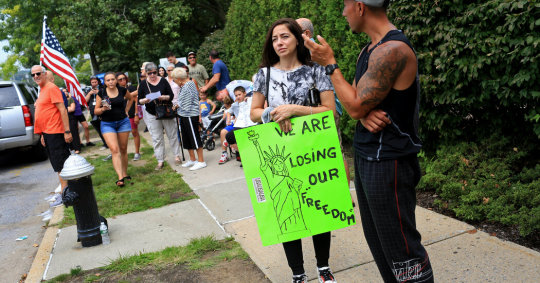
Gov. Kathy Hochul of New York is considering calling in the National Guard and recruiting medical professionals from other states to cover looming staff shortages at hospitals and other facilities as the likelihood grows that tens of thousands of health care workers will not meet the state’s deadlines for mandated vaccinations.
In a statement released on Saturday, the governor’s office said Ms. Hochul was laying plans for an executive order to declare a state of emergency that would “allow qualified health care professionals licensed in other states or countries, recent graduates, retired and formerly practicing health care professionals to practice in New York State.”
Other options, the statement said, included calling in medically trained National Guard members to deliver care and to work with the federal government to deploy Disaster Medical Assistance Teams, which are operated by the Department for Health and Human Services.
Hospital and nursing home employees in New York are required to receive a first dose of a Covid-19 vaccine by 11:59 p.m. on Monday night, while workers working in home care, hospices and other adult care facilities must do so by Oct. 7, according to state regulations and a mandate issued on Aug. 16 by former Gov. Andrew M. Cuomo.
State vaccination figures show that, as of Wednesday, 16 percent of the state’s roughly 450,000 hospital workers, or about 70,000, were not fully vaccinated. The data show that 15 percent of staff at skilled nursing facilities and 14 percent of workers at adult care facilities are also not fully vaccinated, representing another 25,000 or so workers.
Eileen Toback, executive director of the New York Professional Nurses Union, which represents 1,500 nurses in Manhattan and supported the vaccine mandate, said she appreciated that Ms. Hochul was trying to address possible staffing shortages. But Ms. Toback criticized the state for issuing the plan only 48 hours before thousands of health care workers could lose their jobs.
“That could be devastating, particularly when hospitals staff only the exact numbers they need,” Ms. Toback said. “There’s no fat on that bone.”
Ms. Toback said about 5 percent of her union’s members have not been vaccinated. “I believe a lot of unvaccinated employees, not just nurses, are banking on the fact that they are so necessary that they won’t be terminated, and they are holding out,” she said.
The governor’s office said workers terminated because they refuse to be vaccinated are not eligible for unemployment insurance unless they provide a doctor-approved request for a medical accommodation.
In announcing New York’s determination to enforce its deadline, Ms. Hochul said, “We are still in a battle against Covid to protect our loved ones, and we need to fight with every tool at our disposal.” She also commended the vast majority of state health care workers for getting vaccinated and urged “all remaining health care workers who are unvaccinated to do so now so they can continue providing care.”
The Greater New York Hospital Association, which represents about 140 health systems and 55 nursing homes, had not issued a response to the governor’s plan but has supported the deadline for health care workers’ vaccinations, signaling that staffing shortages can be managed.
Understand Vaccine and Mask Mandates in the U.S.
Vaccine rules. On Aug. 23, the Food and Drug Administration granted full approval to Pfizer-BioNTech’s coronavirus vaccine for people 16 and up, paving the way for an increase in mandates in both the public and private sectors. Private companies have been increasingly mandating vaccines for employees. Such mandates are legally allowed and have been upheld in court challenges.
Mask rules. The Centers for Disease Control and Prevention in July recommended that all Americans, regardless of vaccination status, wear masks in indoor public places within areas experiencing outbreaks, a reversal of the guidance it offered in May. See where the C.D.C. guidance would apply, and where states have instituted their own mask policies. The battle over masks has become contentious in some states, with some local leaders defying state bans.
College and universities. More than 400 colleges and universities are requiring students to be vaccinated against Covid-19. Almost all are in states that voted for President Biden.
Schools. Both California and New York City have introduced vaccine mandates for education staff. A survey released in August found that many American parents of school-age children are opposed to mandated vaccines for students, but were more supportive of mask mandates for students, teachers and staff members who do not have their shots.
Hospitals and medical centers. Many hospitals and major health systems are requiring employees to get a Covid-19 vaccine, citing rising caseloads fueled by the Delta variant and stubbornly low vaccination rates in their communities, even within their work force.
New York City. Proof of vaccination is required of workers and customers for indoor dining, gyms, performances and other indoor situations, although enforcement does not begin until Sept. 13. Teachers and other education workers in the city’s vast school system will need to have at least one vaccine dose by Sept. 27, without the option of weekly testing. City hospital workers must also get a vaccine or be subjected to weekly testing. Similar rules are in place for New York State employees.
At the federal level. The Pentagon announced that it would seek to make coronavirus vaccinations mandatory for the country’s 1.3 million active-duty troops “no later” than the middle of September. President Biden announced that all civilian federal employees would have to be vaccinated against the coronavirus or submit to regular testing, social distancing, mask requirements and restrictions on most travel.
Michael A.L. Balboni, executive director of the Greater New York Health Care Facilities Association that represents about 80 nursing homes in the metropolitan area, applauded the governor’s effort to get more health care workers vaccinated but expressed concern about staffing shortages.
“This is a paradox, in that in trying to protect the residents and staff you don’t have enough people to provide the services and you could put people in jeopardy,” Mr. Balboni said.
Ms. Toback said retirees and others could play a role in helping to alleviate shortages, as they did early in the pandemic. But she said replacement workers were no substitute for experienced nurses who have worked at the same hospital for “13 shifts a month, every month, for years.”
“Nurses have been through a great deal — they’re burned out — and although we appreciate the need for what we need to get through this pandemic, this is just hitting people when they’re down,” Ms. Toback said.
Northwell Health, which operates 19 hospitals in the state, said in a statement that it “wants to reassure the public that patient care will not be affected” by the mandate and that it was working on contingency plans to meet staffing needs.
Unvaccinated employees at Northwell Health have been notified that they could be terminated if they do not receive at least their first dose of the vaccine by the deadline, the statement said.
“We are optimistic that we will soon be able to provide a fully vaccinated staff to our patients and the communities we serve,” the statement said.
Michael Levenson contributed reporting.
via Wealth Health
0 notes
Link
How much you sleep can be just as important to you reaching your weight loss goal as how much you eat. When dealing with sleep deprivation, a cascade of reactions in your body is triggered that can interfere with everything you do to help you lose excess weight while you’re awake.
We’ll explain how in a moment, but let’s start with this fact: About 35 percent of U.S. adults are not getting the recommended minimum of seven hours of sleep each night, according to a study by the Centers for Disease Control and Prevention (CDC).
Stress is a common cause of sleep loss, but lifestyle habits such as watching television or scrolling through social media while in bed, late-night eating and inconsistent bedtimes and waking hours have also been linked to reduced sleeping time. The more you can do to sleep a consistent seven or more hours per day, the stronger your likelihood of weight loss success.
Here’s five ways sleep deprivation is slowing your weight loss:
1. Your hunger spikes.
When you’re constantly tired, your body’s levels of two appetite-regulating hormones, ghrelin and leptin, are changed, leaving you feeling hungry even when you’ve had enough food. “These differences in leptin and ghrelin are likely to increase appetite,” say research published in PLOS Medicine.
2. You’re more likely to choose fattening foods.
Sleep-deprived people are more likely to eat snacks high in carbohydrates, according to a study, published in the American Journal of Clinical Nutrition. People who sleep less than the recommended seven hours each night “ate more calories and fat in snacks—nearly 1,000 calories and twice the fat—in the early evening compared to only 600 calories in snacks when they had a full night’s sleep,” conclude researchers at the University of Chicago.
3. Your body burns less fat.
Even when your body is burning off excess calories, lack of sleep changes the types of calories that you lose. Researchers, who reported their findings in the Annals of Internal Medicine, observed that subjects who don’t get enough sleep burn less fat—as much as 55 percent less—while their calorie consumption and overall diet may remain the same.
4. You exercise less.
While no studies have clearly documented it, common sense and practical experience suggest that when you are dealing with sleep deprivation, you have less energy to get through your day. Plus, you feel too fatigued to get in the daily exercise you need to keep burning calories. Physical activity, such as walking, helps your body burn calories and turns flab into muscle. If you’re too tired to be active, you miss out on the valuable weight loss benefits you get from it.
5. Your risk of obesity and diabetes goes up.
People who don’t sleep enough are more likely to suffer from obesity and Type 2 diabetes, says a report in the Journal of Applied Physiology.
What can you do to be sure you are getting enough shut-eye every night?
The CDC recommends that you set and maintain a regular sleep schedule as best you can, even on weekends and vacations. Make sure your bedroom is quiet, dark and free of distractions. Avoid eating less than an hour before bedtime. Get a little exercise in during the day, even when you’re feeling fatigued. Being physically tired will help you sleep more soundly at night.
If you suffer from sleep apnea or any disorder that keeps you from deep sleep, be sure to discuss it with your physician. And, last but not least, follow your Nutrisystem weight loss plan so you can sleep easy knowing you’re doing all you can to be healthy.
via Wealth Health
0 notes
Link
HHS Secretary Xavier Becerra and Chiquita Brooks LaSure at her swearing in ceremony on May 27.
The U.S. Department of Health and Human Services (HHS) and Treasury Department issued a sweeping final rule on September 17th that seeks to make marketplace coverage more equitable while reversing Trump-era regulatory changes under the Affordable Care Act (ACA). On Wednesday, Centers for Medicare and Medicaid (CMS) Administrator Chiquita Brooks-LaSure discussed the need for these and other Biden-promoted health provisions, placing them in the context of widening health inequities during Covid-19.
“No one should be left out, left behind, or left on the sidelines when it comes to healthcare,” Brooks-LaSure said. “As the first African-American woman to lead CMS, I want to make sure that our programs are operating to reduce the health disparities that underlie our healthcare system, which were particularly illuminated in the Covid pandemic.”
The rule in a nutshell
The rule extends the 2022 open enrollment period for Healthcare.gov by 30 days, to January 15. It also raises the federally-run marketplace user fee from the 2.25% of premiums approved under the Trump administration in January to 2.75% and the state-run exchanges from 1.75% to 2.25%, to cover increased outreach costs.
Most notably, the rule introduces a new Special Enrollment Period (SEP) for low-income uninsured people, including lawfully-present immigrants, each month. Inspired by the wild success of the American Rescue Plan Act‘s SEP this year, this provision seeks to ensure that traditionally underinsured groups don’t miss their chance to get covered as soon as they learn about the marketplace’s benefits.
More time to weigh marketplace options
HHS justified its decision to extend the deadline for joining the marketplace by explaining that many patients who are auto-enrolled need that extra time to consider whether the level of insurance they are purchasing is correct for their needs and to change premiums if it is not. Many state-run exchanges already have enrollment periods ending January 15. Consumer advocate commenters were supportive of this aspect of the proposed rule.
Marketplace insurers, on the other hand, had argued the later deadline would lead to “adverse selection,” wherein healthier enrollees delay signing up for coverage until the last minute, while sicker people would enroll earlier, thus increasing costs and premiums. However, HHS determined that the overall benefits outweighed this risk.
Expanding awareness
The Centers for Medicare and Medicaid Services (CMS) expects to use the $200 million in fees generated through this increase to make ACA more equitable by increasing awareness and access to underserved populations.
This includes a fourfold expansion to 1,500 healthcare navigators in the 2022 coverage year that it paid for through an $80 million grant issued earlier this year. CMS will also re-launch the “Champions for Coverage” program, where community organizations educate consumers about Healthcare.gov, Medicaid and the Children’s Health Insurance Program (CHIP).
The agency further plans to use the fees to train these navigators and community agencies in guiding low-income, non-native English speaking and other underserved enrollees through more sticky post-enrollment issues. Community educators will become experts in how to appeal a marketplace rejection and reconciling premium tax credits, among other topics, according to CMS.
In a fact sheet, CMS noted the proposed rates were still lower than those currently being paid in the 2021 benefit year, which were 3% for the federal marketplace and 2.5% for state-based exchanges. Stakeholders, including marketplace insurers, were generally supportive of this rate change.
Allowing low-income uninsured to enroll year-round
The rule introduces a new Special Enrollment Period (SEP) that will open the marketplace on a monthly basis to low-income consumers who are eligible for advance premium tax credits and earn up to 150% of the federal poverty level (FPL), including lawfully-present immigrants.
This will provide an affordable option for millions of people expected to lose Medicaid coverage at the end of the declared public health emergency, according to CMS Administrator Chiquita Brooks-LaSure.
“We are poised and ready to help support states on eligibility and enrollment actions after the public emergency ends,” Brooks-LaSure said in a presentation to state marketplace leaders on Wednesday. “This unwinding will take a strong partnership between the states and CMS to ensure consumers are seamlessly covered for necessary services.”
While the new policy will be permanent, it will only be active when its target population qualifies for the maximum advance premium tax credit, meaning when Congress sets taxpayers’ premium contribution to zero percent, as it has under the American Rescue Plan Act (ARPA).
Under ARPA, health insurance consumers making up to 150% of FPL qualify for either free or extremely affordable premiums on benchmark Silver plans, as well as cost-sharing reductions that render their coverage platinum-equivalent. Though ARPA’s enhanced subsidies are temporary, Congress is currently debating whether to make them permanent, which would extend the duration of this new income-based SEP. Brooks-LaSure called this extension of enhanced subsidies “critically important.”
“We’ve gotten to see what a difference enhanced subsidies and enhanced outreach efforts make at the beginning of our [latest] Special Enrollment Period,” Brooks-LaSure said. “We saw an increase right around the time the administration opened up the SEP: we put $10 million on the table to navigators and we saw a bump up, which was wonderful to see; and then the ARPA subsidies took effect and we saw quite a bump up — when we see that, what we are seeing is that when we make coverage affordable, what a difference it makes in terms of enrollment.”
Eradicating the state private opt-out
While it made participation in the low-income SEP optional to state-based exchanges (SBEs) and allowed states to set their own open enrollment deadlines, as long as they fall on or after December 15, 2021, the rule eradicated the option for private, state-level Exchange Direct Enrollment (Exchange DE) programs.
The Exchange DE program was inspired by Georgia’s Section 1332 waiver, which allowed that state to opt out of Healthcare.gov and instead use its own network of private insurers. Consumer and state advocates had expressed concern such private exchanges would confuse consumers and increase the risk of abuse by fraudulent actors.
HHS went further, saying that supporting this program was antithetical to the Biden Administration’s priorities and it was going to invest resources in doing the “unfinished work of the ACA,” as Brooks-LaSure puts it.
“It was never intended for the lowest-income among us not to have coverage,” Brooks-LaSure said, “and we are very happy to work with states that want to expand — I hope states will take up the Medicaid expansion… but if for whatever reason the states are not in that position, we need a federal solution and I think that Congress is seeing the importance of covering everyone, whether that’s through the marketplace, whether that’s through a federal Medicaid program, the important issue I would say is making sure people have coverage.”
Getting ACA back on track
This was HHS’ first rule addressing the federal and state healthcare marketplaces, which Jessica Altman, Commissioner, Pennsylvania Insurance Department (PID) jokingly refers to as the “third M” in CMS.
She joined her fellow state marketplace leaders in celebrating the rule’s proposals.
“PID is pleased with the steps that HHS has taken through this rule, which returns the individual health insurance marketplace to the trajectory it was on under the Obama Administration and builds on the opportunities Congress provided under the American Rescue Plan Act,” Commissioner Altman said in an email.
While Pennsylvania is not accountable for many of the rule’s requirements as a state that manages its own exchange, Commissioner Altman said she looked forward to implementing the SEP for low-income people as part of Pennsylvania’s state exchange, Pennie.
California’s exchange is already a step ahead, opening up an SEP this month to protect enrollees set to lose their federal health subsidies. Its director applauds the rule’s consumer-centric expanded SEP and other enrollment-boosing provisions.
“The final rule demonstrates the Biden Administration’s commitment to both reverse actions taken by the prior administration to undercut the ACA and to implement new policies that can promote more enrollment,” Peter Lee, executive director of Covered California, said in an email. “We’re seeing this administration lean in, using all the tools they have to expand coverage in meaningful ways.”
via Wealth Health
0 notes
Link

As I shared in a previous column, two years ago I was privileged to enjoy a trip to Colorado to hunt western game. My father’s taxidermy shop implanted a lifelong dream within me to pursue elk and mule deer and experience the Rockies.
Having been warned by veteran hunters, I began preparing physically for the challenges of this trip. Western altitudes and steep mountainsides demand physical fitness that most Virginia hills do not require.
So I began to train. Starting in mid-summer, I walked each morning. After a few days, I began carrying my backpack and gradually added weight working up to a 50 pound payload.
By the time I left home in mid-October, I was in better shape than I’d been in in quite a while and felt good about being up to the challenge. We arrived in Pagosa Springs less than 30 hours later and set up camp in the National Forest anticipating the monsters we would harvest. Then came the first day of hunting.
Although I didn’t suffer from altitude sickness, there’s not much one can do to prepare for an extra 7,500 feet of elevation. In addition, the hillsides were steeper than I expected and my hunting partner was in better shape. When he took off up a hill, I started sucking wind. Thankfully, he had mercy and stopped often for me to recover.
The evening he harvested a nice bull elk, we were all excited but each of us was needed to transport the meat back to camp. They loaded me up for the short half mile hike during which time I thanked God with every step that it was mostly downhill and not any longer.
I thought I was well prepared for what I faced. I wasn’t. While I was glad I did what I had done, I regretted not doing more. After arriving, there was no way to suddenly get more fit.
This experience reminded me of the importance of spiritual fitness. Few even consider this concept until facing a life-challenge of losing a job, health, or a loved one. Confronted with difficult emotions along with troubling questions, we can easily collapse under the strain.
Ideally, we would exercise regularly to stay physically fit. Such a strategy eliminates the need for serious workouts prior to a challenge and helps to ensure we’re ready for whatever comes. If troops fail to train before battle, there is nothing they can do to suddenly get ready when attacked. Rigorous training prepares for rigorous tests.
The same is true spiritually. It’s not a question of “if” difficult situations will arise, but “when.” Unlike a planned trip, they often occur unexpectedly. If we fail to train for spiritual struggles, we shouldn’t wonder why they easily overwhelm us. Although such times are still tough, prior preparation can make them less stressful.
While physical preparation involves all types of exercises, so does spiritual fitness. Making time to pray daily as well as reading and meditating on God’s Word, worshiping often, and even periodic fasting will build our spiritual muscles and develop our capacity to not only endure our own problems, but to help others carry their burdens as well.
Fitness experts also advise having a training partner for accountability and inspiration. The same applies spiritually. Spouses, friends and fellow church members can help us as we grow stronger in the Lord together.
Although we may take such people for granted, we suddenly gain new appreciation for family and our Christian brothers and sisters when challenges arise. Pastors and friends can also assist us in navigating the new altitudes and difficult terrain.
At times, it seems our hills are too steep to climb. But as we help each other and as God assists us, we find ourselves making good progress.
As local hunters depart for their western excursions this fall, may their experiences remind us of our own need to become and stay spiritually fit.
Blessings, George
via Wealth Health
0 notes
Link
Elligo Health Research, a clinical research and technology company, has raised $135 million in a new funding round led by Morgan Stanley Expansion Capital and Ally Bridge Group.
Existing investors, including Cerner, Norwest Venture Partners, Hatteras Venture Partners and Syneos Health, also participated in the Series E financing round.
Founded in 2016, Austin, Texas-based Elligo Health Research aims to expand patient access to clinical trials. It uses EHR data, technology and services to support all types of clinical trial designs — traditional, hybrid and direct-to-patient. The organization has access to the data of 150 million diverse patients.
“The clinical trials industry is experiencing a new phase of disruption,” said Melissa Daniels, managing director and general partner at Morgan Stanley Expansion Capital, in a news release. “There’s an opportunity to use technology, data analytics, and services to eliminate long-standing trial conduct pitfalls and bottlenecks that primarily impact patients.”
Daniels has joined Elligo’s board.
The company will use the new funds to purchase ClinEdge, a research practice management and clinical services organization. ClinEdge delivers site conduct and patient access solutions for clinical research sites, pharma companies and clinical research organizations.
In addition to the acquisition, Elligo will further invest in its technology platform and develop new ways to use data to enhance how clinical trials are run.
“This commitment from Morgan Stanley Expansion Capital, Ally Bridge Group, and others will not only help us better serve our existing clients, but also empower us to expand our technology and services on a global scale,” said John Potthoff, CEO of Elligo Health Research, in a news release. “The net effect of that will be increased access to clinical trials as a care option for large numbers of patients. We will accelerate revolutionizing the way clinical trials are conducted from pre-identification of patients through healthcare to study enrollment, conduct, and study data delivery.”
Among Elligo’s existing investors is EHR giant Cerner, which has an established relationship with the company.
Last December, Cerner invested an undisclosed sum in Elligo Health Research. As part of the investment, Cerner also announced plans to enter into a commercial agreement with Elligo to offer additional clinical trial resources to providers in the Cerner Learning Health Network.
Photo: abluecup, Getty Images
via Wealth Health
0 notes
Link
Show Full Article
With Halloween coming up, the influx of candy in the grocery store aisles may mean temptation is lurking around every corner. While those sugary sweets might feel frighteningly detrimental to your healthy diet, you can whip up some equally satisfying but guilt-free homemade Halloween candy at home in little to no time at all!
Swapping your Halloween candy with these healthier alternatives will make the Halloween season much less spooky—at least when it comes to your health.
When it comes to simple Halloween candy, it doesn’t get much easier than four ingredients! These candy bites are made with corn flakes, peanut butter, brown rice syrup and chocolate chips. With the beloved combination of peanut butter and chocolate—plus just a bit of crunch—these bites have all the indulgence of a candy bar without the guilt. Get the full recipe here! >
There’s something about the classic combination of peppermint and chocolate that makes it a favorite Halloween treat for many. This simple recipe makes small “gem-sized” candy bites that have a hint of coconut, too. They’ll satisfy your sweet tooth while still clocking in under 100 calories per serving. Get the full recipe here! >
The combination of chocolate and raspberry has a decadence about it that really makes it feel like a gourmet treat! These chocolate raspberry cups are made using just four ingredients—frozen raspberries, chia seeds, coconut oil and chocolate chips. We also have lots of suggestions of healthy swaps to switch up the flavor and texture of these delicious treats. Get the full recipe here! >
If you’re someone who loves the flavor combo of mixing sweet with salty, then this is a fudge recipe you’ll have to try. Fudge is one of those desserts that seems difficult to make when in reality, there’s not much more to it than mixing! In little to no time at all, you can whip up a decadent treat to enjoy. Get the full recipe here! >
Chocolate peanut butter cups are perhaps one of the most beloved Halloween candies out there. But they’re also packed with sugar. Our version cuts down on the amount of sugar from the store-bought variety using just three ingredients—chocolate chips, coconut oil and peanut butter. They’ll still satisfy your sweet tooth but without completely derailing your healthy eating regimen. Get the full recipe here! >
Think bite-sized pecan pies that you can whip up with a handful of simple ingredients. Simply blend the ingredients, pop in the freezer to set and enjoy! The result is that decadent fudge taste and texture that makes it so craveable—all with the delicious appeal of pecan pie. Get the full recipe here! >
If you love pumpkin flavored treats, then this delectable candy is sure to become a new favorite. These truffle balls have a tasty filling made from pumpkin puree, cashew butter, maple syrup, blanched almond flour and pumpkin pie spice. The filling then firms up in the fridge before being dipped in its chocolate coating and once again heads back to the refrigerator to set. The end result tastes like a mini, portable pumpkin pie smothered in chocolate. Make these for Halloween or any other fall holiday; they even make a cute gift! Top them with chopped nuts or cacao nibs for some extra crunch. Get the full recipe here! >
At under 100 calories per serving, these chocolate pecan caramel bites are a healthier way to indulge your love of chocolate. They’re the perfect combo of pecans, caramel and Nutrisystem NutriChocolaty Wafers. Plus, they are simple to make and assemble. Get the full recipe here! >
If you’ve never made chocolate bark before, it involves melting chocolate, sprinkling in desired add-ons and spreading on a sheet pan to set in the fridge. Our chocolate bark recipe is super simple using just dark chocolate, orange zest and coarse salt for a tangy “salted orange” flavor. Break off a piece to satisfy your sweet tooth without getting your healthy eating plans off track. Get the full recipe here! >
These delicious snack bars use six simple ingredients, including rice cereal, cocoa powder, peppermint extract and chocolate chips, to whip up a gooey-chewy bar that is so satisfying to bite into and enjoy. It’s a great alternative to diving into the candy bowl and overindulging on sugar. Get the full recipe here! >
Here’s another delicious fall-inspired fudge recipe that’s incredibly simple to make. Just puree walnuts with coconut oil, maple syrup, maple extract and stevia (if desired), and pour into an ice cube tray to set. Besides being delicious, this fudge also packs in six filling grams of fiber and five grams of protein. That makes it a fudge you can feel good about. Get the full recipe here! >
If you love the flavor combo of mint and chocolate, then these brownie bites are your perfect indulgence! Instead of turning to the candy bowl, whip up these bite-sized brownies which have just 87 calories per serving. Avocado is the secret ingredient to making a creamy and healthy mint filling in these delectable treats. Get the full recipe here! >
Another mint plus chocolate combo, this peppermint cup recipes will yield 10 homemade candies that clock in at just 49 calories each. They’ve got the refreshing sweetness that you desire and they’re just the right size to pop in your mouth and curb your cravings. Get the full recipe here! >
No flavor quite summons the “fall feels” like pumpkin spice! And now you can enjoy it in a decadent fudge that is super easy to make and won’t put you in a sugar coma. Simply mix together some ingredients like almond butter and pumpkin puree, transfer to an ice cube tray and pop in the freezer to set! One piece of fudge is just 82 calories. Get the full recipe here! >
As we’ve said before, it’s hard to go wrong with the powerful flavor duo of chocolate with peanut butter! And unlike traditional candy bars which can be a diet disaster, these bars are actually made from healthful ingredients like dates, peanut butter, oats and even some Vanilla Nutrisystem Shake Mix for more protein and flavor. Get the full recipe here! >
Instead of grabbing a handful of syrupy-sweet candy corn, this parfait will get you into the Halloween spirit but without the empty calories. While it’s technically not “candy,” the sweet flavors and creamy cottage cheese are sure to satisfy your cravings and keep you full. It layers diced pineapple, orange and cottage cheese for a healthy snack with spooky spirit. Get the full recipe here! >
This creamy and decadent fudge has the fabulous flavors of chocolate and peanut butter. But it uses just peanut butter, unsweetened vanilla almond milk and some Nutrisystem NutriChocolaty Wafers, so you can indulge guilt-free. Simply mix up the three ingredients, spread in an ice cube tray and freeze to set. Get the full recipe here! >
Our Pumpkin Spice Bars are just as delicious as a store bought candy bar. They’re crispy yet chewy and filled with bursts of pumpkin spice flavor. At just 52 calories per serving, they are totally Nutrisystem-approved. Get the full recipe here! >
Apple picking season is upon us! We’ve lightened up the classic caramel apple so that you can enjoy it while you lose weight. These Chocolate Caramel Apples are super tasty and less than 100 calories. Before the chocolate and caramel hardens on the apples, we top them with crushed nuts for some extra crunch and healthy fats. Get the full recipe here! >
Dates are pretty much nature’s candy. We stuff them full of creamy almond butter and sprinkle on various toppings for a wholesome homemade candy recipe that you can feel good about. Get creative with your favorite healthy toppings, including chopped almonds, shredded coconut, chocolate chips and pomegranate seeds. Get the full recipe here! >
via Wealth Health
0 notes